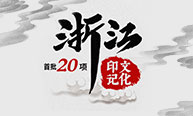Folk Music
Ningbo Zou Shu
Ningbo Zou Shu, also known as Lian Hua Wen Shu and Li Hua Wen Shu, was a kind of singing-and-talking art performance prevailing around Ningbo and Zhoushan. The performance featured story-telling and walking. That is to say, performers kept walking around while giving performance. It came into being in the mid-19th century, so it has a history of more than one hundred years so far. The traditional Chinese musical instruments including pi-pa, Er-Hu and Yang-Qin were utilized to play the accompaniment during the performance. Its lyrics were simple, expressive and full of rural flavors and thus highly appreciated by countrymen and fishers.
Shaoxing Pinghu Diao
Shaoxing Pinghu Diao, also known as "Ping Diao" or "Yue Jun Nan Ci" gained its popularity in Zhejiang in the 18th century. It was composed of two parts: introductory song and follow-up stories. It was sung in the official language in Shaoxing, except that the clowns would occasionally use the dialects of Beijing, Suzhou and Hangzho. The performers usually sat down when performing. The singing could either be "San Pin (three instrumental)" with three players playing Xiao-San-Xian, Yang-Qin and Er-Hu respectively, "Wu Pin (five instrumental)" with additional Dong-Xiao and pi-pa, "Qi Pin (seven instrumental)" with further Shuang-Qing and Sheng, or "Jiu Pin (nine instrumental) with even more Yue-Qin (four-stringed plucked instrument with a full-moon-shaped sound box) and Tou-Guan. However, no matter which way it adopted, only the San-xian player would do the singing-and-talking. All other players were only there for accompaniment. Today, the folk art has completely died out.
Shaoxing Ci Diao
Shaoxing Ci Diao, also known as "Hua Diao" or "Hua Ci" was a local folk art of the blind artists prevailing in Shaoxing. Judging from the reversed order of characters "Hua Ci", it must have had close relationship with "Ci Hua" of Yuan and Ming Dynasties. It was a kind of singing-and-talking, but priority was given to the former. Except the foreman, the singing team consisted of mainly female blind artists. It was the same as the Shaoxing Pinghu Diao in its organization and its number of instruments. The San-Xian player, nicknamed "Mr. Xian Wei", was always the foreman and played the role of the elderly or the narrator in the performance. There were three basic tunes-Suo Yi Pu, Ben Diao and Shi Zi Diao, as well as some folk songs. It was said that there were altogether 18 traditional programs, but only 8 of them (totaling 36 acts) could be staged after liberation while the others were lost. Now about 60 "Jie Shi" (introductory stories) remained. It was usually performed on happy occasions such as the wedding, the 30th day after a baby's birth, birthday party and the move to a new house. After liberation, as young blind men were all employed in other lines and there were no trained successors, the art died out together with the old artists.
Shaoxing Tan Huang
Shaoxing Tan Huang, initially known as "Shaoxing Ying Ge Xi (parrot opera)" or "Yang Ge Xi", was a kind of singing-and-talking folk art prevailing around Shaoxing. It developed from the original "Dui Zi Xi (pair opera)" consisting of only a female character and a clown. The singing team was called "Ying Ge Ban (parrot troupe)" and later renamed as "Shaoxing Tan Huang" in 1957. The performers were also members of Shaoxing Folk Art Workers' Association. Besides Shaoing, they used to perform in the northern plain as well as Suzhou and Shanghai. There were usually two musicians in the back (one for the strings and the other for the clappers), and the number of the actors ranged from two, four to six. They were mainly about life and affection of common people. Focusing on only one detail or a specific plot, it mocked, teased and made great fun. People liked its humorous way of reproducing life very much. At present, there were no performers in the line except some amateur singers.

 Print
Print Mail
Mail
 20 Cultural Symbols
20 Cultural Symbols Why Zhejiang
Why Zhejiang Experiencing high-tech products at WIC
Experiencing high-tech products at WIC Zhejiang Release
Zhejiang Release Zhejiang News
Zhejiang News